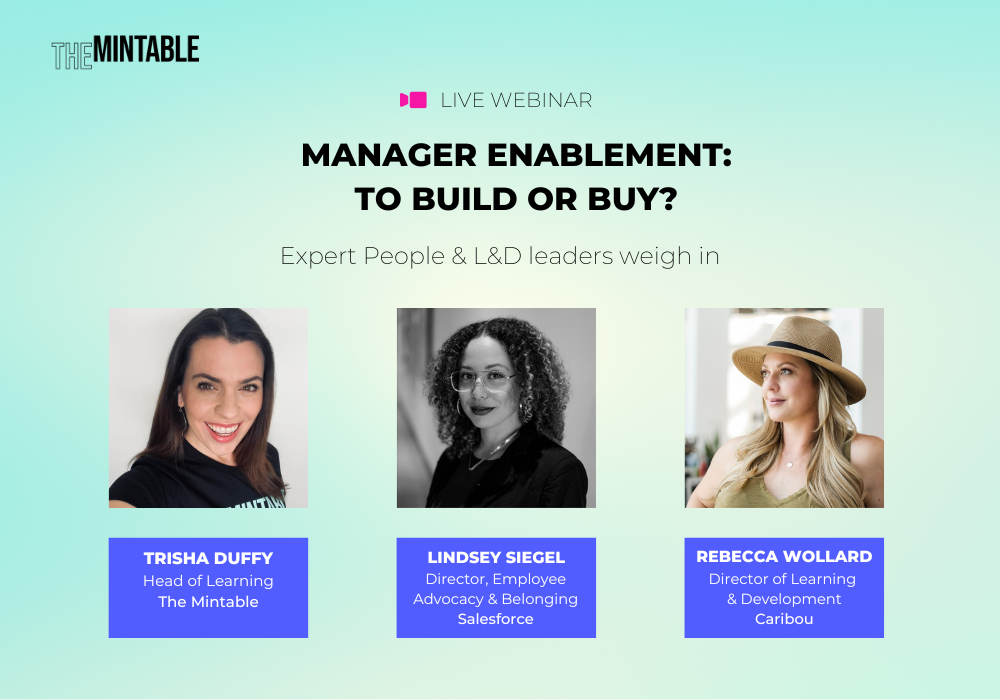
As anyone who works in Learning and Development can tell you, the laundry list of requests has grown longer in recent years, particularly in the area of manager enablement. Inevitably HR comes to a crossroads: is it best to build internally or partner with an external vendor to train and develop leaders?
To help HR and L&D teams navigate this tricky question and enable your teams in the best way, our Head of Learning, Trisha Duffy, recently led a live webinar with seasoned L&D experts Lindsey Siegel, Director, Equality – Employee Advocacy & Belonging at Salesforce, and Rebecca Wollard, Director of Learning & Development at Caribou.
Watch the full webinar below and read on for some key highlights.
Create a decision tree to define the problem you’re solving for
Our panelists agreed that by first defining the training that needs to be produced, you can then determine the best way to get it done. They recommend asking questions to define the need: Who are we designing for? What skills do they need?
Next, it’s important to scope logistics : What is your team’s bandwidth and capacity? Will the training be standalone or repeated?
As part of this exercise, both Lindsey and Rebecca were in furious agreement about the need to establish whether the training you need for managers is specific to your organization or whether it’s general management training that is required.
“Some of the questions I ask myself are: what’s the baseline that everybody needs in order to be successful at Caribou? Are the skills they need general management skills or highly specific to what we do at Caribou?” asks Rebecca.
If the skills required are not specific to Caribou, Rebecca will opt to buy training.
“Chances are somebody’s already created it and if they have they’ve probably figured out a way to operationalize it in a way that would take less off of me and my team,” she says.
If you buy – be smart about presenting your business case to get budget approval
When you go down the buy route, you may need to get budget approval from your finance team or CEO. To build a solid business case, our experts suggest taking the following approach:
- Present the numbers – compare the costs of building the training in-house (such as your salary and potential headcount) to the cost of outsourcing from a vendor.
- Compare options – show that you’ve done your homework. Lay out your research and why your final choice is the right one.
- If it’s a hard sell, propose a pilot – this may be an easier spend to stomach and gives you the opportunity to take finance along for the ride with you.
Rebecca says, “Break down the numbers. Here’s what we would get, the amount that it would cost and how we could actually operationalize it within the organization with no additional headcount. And I could work on these other things while this is all happening over here. So you’re actually getting more for less money. It’s pretty clear once you show them what the numbers actually look like, which is more cost effective.”
Need help building an airtight business case? Check out our free one-page business proposal template.
Sourcing the right vendor will be crucial to your program’s success
Possibly the most crucial of all insights delivered by our speakers, was the necessity of carefully considering who your organization partners with.
“Vendors are partners, vendors are co-creators and collaborators with you along this journey. And it’s imperative if you are going to enter into a relationship where you are intentionally moving people from one mindset to another with changing behaviors that you’re in lockstep with your partner,” says Lindsey.
To make sure a vendor is the right fit, Lindsey and Rebecca recommend doing research to confirm the vendor:
- Has the right mindset and is aligned with your company values
- Provides training you actually need (referrals and testimonials will help here!)
- Resonates with your managers – they provide training in a way that your managers will interact with and respond well to
- Helps you measure and communicate ROI
A big thank you to Lindsey and Rebecca for sharing their insights and their decision making process, and to our Head of Learning Trisha Duffy for leading this session.
We hope these tips help you create repeatable, scalable learning programs for your managers and free up some bandwidth so you can focus your time and energy on learning programs that are hyper specific to your organization.